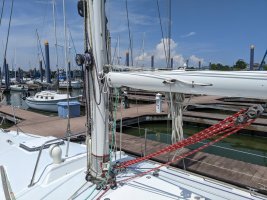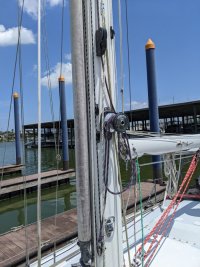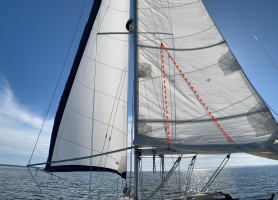To a tiresome degree have I analyzed my own use of lazyjacks. I wound up leaving them up all the time, and a slotted sail cover.
Here are the comparative sequences.
Remove sail cover in slip . In channel, remove a few sail ties and hoist.
Lazyjacks then catch sail for all daysail reefs, meaning I don't have to do anything or leave the cockpit.
When returning to slip, lower sail into lazyjacks. No sail ties, no sail falling on guest heads, no need to leave the cockpit.
In slip, rehoist sail and lower in control so the folds are neat and alternate. (New sail, I didn't use to bother. Lazyjacks really help)
Add a few sail ties to shape lie of mainsail on boom, then sail cover on.
I tried rigging and unrigging lazyjacks each time, which has the benefit of not requiring slots in the sail cover. But it adds procedures, and you must do it before lowering sail on return or the sail falls off the boom. It also means the sail must be sustained on the boom with many sail ties before sail cover put on.
It's hard to say which is better. My case is dominated by "singlehanding," by which I mean, in my world, there may be eight people on the boat but none is familiar enough with the boat, or sailing, to actually help (explaining how-to slows everything down, and even simple nautical terminology seems to confound guests and freeze them like deer on railroad tracks. )
"The lazyjack is fouled on a batten, slack the mainsheet, I'll head up, no, lower the sail a little, jiggle it, try slacking the vang, no, look at the mainsheet, it's fouled, the mainsheet is the line that controls the boom, the boom, the boom, that thing, yes! Slack it and then, no no take it right off the winch, and you'll need two hands, so you'll have to put down the beer, no don't put it there, it'll fall over, look at the foul, do you see it? The foul--I just mean the line is is is is is tangled, it's caught, right? Fouled! Nothing to do with that seagull! Foul with a "u"! No, Tracy, I am not yelling at people, I never yell at people! I'll clear the foul myself, no problem, excuse me, don't let me step on your hands, you'll have to move, Alphonso, scoot over, Alphonso! I need to put my foot where your hand is!"
Perhaps not everyone has these problems.





